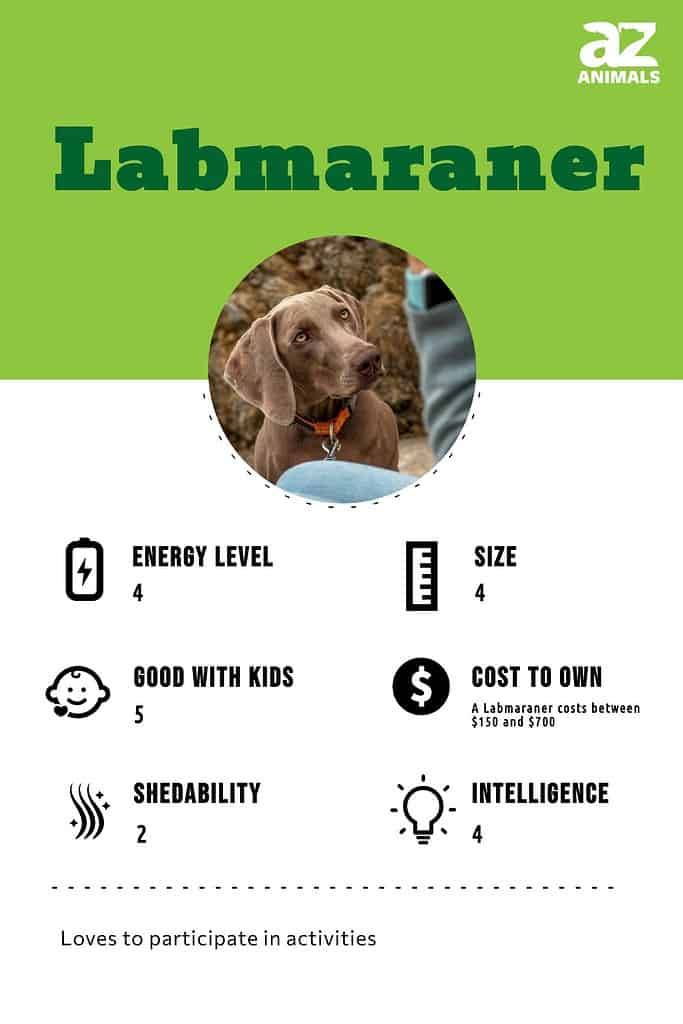Labmaraner
Canis lupus
Loves to participate in activities.
Advertisement
Labmaraner as a Pet:
- General Health
- Energy Level
- Shedability
- Trainability
- Intelligence
- Tendency to Chew
- Size
- Family and kid friendliness
- Yappiness / Barking
- Low
- Separation Anxiety
- Moderate
- Preferred Temperature
- Average climate
- Exercise Needs
- High
- Friendly With Other Dogs
- Group
- Pure bred cost to own
- $150-700
- Dog group
- Working
- Male weight
- 70-90 lbs
- Female weight
- 55-75 lbs
This post may contain affiliate links to our partners like Chewy, Amazon, and others. Purchasing through these helps us further the A-Z Animals mission to educate about the world's species.
View all of the Labmaraner images!
Labmaraners are prized working dogs. They are used as guide dogs and in search and rescue as well as hunting and retrieving.
The Labmaraner, also called Weimaraner Lab, Labraraner, or Weimador, is a hybrid, mixed, or designer dog breed that is a cross between a Labrador Retriever and a Weimaraner. It is a large-sized dog with a usually short coat that is glossy, flat, and in common colors of brown, yellow, black, silver, or grey. As a new breed in the U.S., it originates from 19th-century Germany. The breed makes a great family pet and gets along well with children and other dogs. Intelligent and eager to please, it is also highly valued as a working dog.
See all of our expert product reviews.

3 pros and cons of owning Labmaraners
| Pros! | Cons! |
|---|---|
| It’s social. This breed loves to be around people and other dogs. In fact, it prefers being in a pack with other dogs, if possible. | Separation anxiety You shouldn’t leave this breed all by itself for longer than a few hours. If you’re taking an extended leave from home, it’s best to leave it with other people or other dogs. |
| Intelligent and trainable You can train this breed to do a variety of tasks, especially those having to do with guiding people and retrieving. Thanks to its parents, it has qualities from both working breeds. | Not hypoallergenic Although it doesn’t shed much, allergy suffers will still react to its fur. Not only does it shed its coat seasonally but regularly, which can be maintained through regular brushing. |
| Barks occasionally This breed only barks to alert its owner of strange noises, with the exception of bad socialization and lack of training during puppyhood. It makes a great watch or guard dog. | High-energy This is a very active, lively as well as large breed, and it is prone to wanderlust and attempts to escape. It is not suitable for apartment living but instead needs to live in a house with a yard. |

©iStock.com/Manel Subirats
Size and Weight
The Labmaraner is a large size short hair dog with an average height of 24 inches for males and 22 inches for females. Males weigh about 80 lbs fully grown, while females weigh about 65 lbs fully grown. Labmaraner puppies weigh 17 lbs on average at 7 weeks of age and are typically fully grown at 12 months.
| Height (Male) | 24″ tall |
| Height (Female) | 22″ tall |
| Weight (Male) | 80lbs, fully grown |
| Weight (Female) | 65lbs, fully grown |
Origins

Labmaraners inherit their patience and gentle nature from their Labrador parents
©Jagodka/Shutterstock.com
Labmareners or Weimadors as they are also known, are a mix of Weimaraners and Labradors. As a result, they have German origins owing to the former which hail from Weimar and represent a nobleman’s dream of creating the ultimate hunting breed. They also bear the endurance, intelligence, and strength of a breed which was used in hunting wild boar and deer.
Health and Entertainment for your Labmaraner
See all of our expert product reviews.
Those qualities are further enhanced by their Labrador parentage – their Canadian and British forebears were engaged in hunting and fishing expeditions.
As a result, this breed requires a great deal of exercise to enable it to put its boundless energy to good use.
It is also a great fit for kids owing to its gentle nature inherited from its Labrador parents.
Common Health Issues
The Labmaraner, although it is a hybrid dog, has some of the same health issues shared by its parents, the Labrador Retriever and the Weimaraner. Reputable breeders who charge a higher price do health screenings to minimize risk of inherited conditions. Nonetheless, these well-built, muscular dogs are still vulnerable to certain issues. Possible issues that may occur are epilepsy, bloat, eye problems, ear infections, OCD, heart problems, cold tail, and joint dysplasia, which you can be aware of with testing at your local vet. Any dog can have bloat, but it’s more common in large, deep-chested breeds, including the Labmaraner.
OCD can occur in dogs that are lonely, bored, stressed, frustrated, or seeking attention as exaggerated and repetitive normal behaviors. Ear infections can occur in dogs with large floppy ears. Cold tail can happen to dogs who engage in prolonged swimming or get chilled or wet while on a walk and is more common among large working dogs. In short, the most common health issues unique to Labmaraners are:
- Obesity
- Eye problems
- Heart problems
- Joint dysplasia
Temperament and Behavior
The Labmaraner is a hybrid of the Labrador Retriever and Weimaraner, and so inherits traits from both parents. Its personality is commonly friendly, loyal, social, and energetic, with a gentle, loving temperament. It is quick to mature but will display high-activity behavior in adulthood.
How To Take Care of Labmaraner

Labmaraners are large and energetic like their Weimaraner forebears and as a result require a great deal of exercise
©Csanad Kiss/Shutterstock.com
New dog owners looking to care for Labmaraners, especially Labmaraner puppies, must consider its parent breeds. Whether it’s joint dysplasia or different care related to their large size and body build, the hybrid dog has unique factors that should be considered to ensure proper health, development, and socialization.
The Best Dog Food for Labmaraners
Labmaraners, especially puppies, have certain health considerations that are unique to being a hybrid dog breed. Therefore new owners should consider these factors when choosing a food for their pet:
Legumes in dog food have been linked to heart failure in dogs. So Labmaraner owners should educate themselves on legume-free dog food, since this breed can develop heart issues.
Labmaraner puppy food: Labmaraners tend to experience obesity, eye problems, heart problems, and joint dysplasia, so it’s important to feed them the proper diet since puppyhood. You can either feed your Labmaraner puppy a grain-free large breed puppy dry or canned food, opt for commercial raw dog food, or create your own DIY raw diet that includes ground bone, vegetables, vitamins, and minerals. Be sure not to over-feed them whether by the amount of food you give or how many times you feed them a day.
Labmaraner adult dog food: Similar to puppy food considerations, pet owners should consider feeding their adult Labmaraner food with a lot of protein, non-starchy vegetables, calcium, and other vitamins and minerals. Because Labmaraners are an active breed, we recommend feeding them an active dog food variety that can deliver the nutrition they need for their energy demands.
All this considered, we think the best dog food for Labmaraners is Purina Pro Plan Large Breed & Giant Breed Chicken & Rice Adult Dry Dog Food & Wet Dog Food at A-Z Animals.
The benefit of the high-protein recipe is that your Labmaraner will know when it’s had its fill and will be less likely to overeat. At the same time, they’ll get the complete nutritional profile they need for an active life. There’s real rice, with quality chicken and other poultry for glucosamine, essential for long-term joint durability. An omega 3 fatty acid called EPA supports heart health, too.
Check Amazon and Chewy for this product.
- Crunchy kibble combined with tender, shredded pieces for taste and texture dogs love
- High protein formula, with real chicken as the first ingredient
- Fortified with guaranteed live probiotics for digestive and immune health
- Used to be known as SAVOR Shredded Blend Large Breed Formula
- Glucosamine and EPA, an omega-3 fatty acid, for joint health and mobility
Maintenance And Grooming
The common coat colors of this hybrid dog are black, yellow, brown, silver and grey. They shed their coats regularly and seasonally as do many other dog breeds, and although they don’t shed much, they are not hypoallergenic. Black coats are the most conspicuous on your floor or furniture. Regardless, it doesn’t take much to keep your dog’s coat glossy. For puppies, brush them twice a week; for adult dogs, once a week with a slicker brush is all you’ll need.
Training
The Labmaraner is no harder to train and socialize than other puppies. In fact, since it is intelligent and eager to please, it will pick up tasks easily and enjoy mental stimulation, tackling new commands with fewer repetitions than other breeds. It particularly enjoys working on activities as a “pack” with you or with other dogs. Also, it naturally has an average prey drive, so it won’t have a high impulse to chase and catch cats and smaller animals, but it’s still possible. Do not allow your Labmaraner off-leash unless it is in an enclosed space.
Labmaraner Exercise
Labmaraners are muscular dogs and need a lot of exercise to stay healthy and happy. For this reason, they need owners who are active so they can enjoy exercising together. You can expect high exercise needs of 60+ minutes daily, with variety to prevent boredom. This is also a large breed, so it will not do well in apartments. Instead, it needs to live in a house with a yard to run around in.
Playing fetch, interactive games with family, or with toys are all possibilities. Running off-leash in a securely fenced backyard is a must. Visiting a dog park is great for socializing with other dogs. Daily walks are also a must, and accompanying you for a swim, run or hike will give you two quality time together as well as variety. Exercise for Labmaraner puppies should be limited until they reach maturity, with a general rule being 5 minutes for each month of age.
Labmaraner Puppies

Labmaraners demand a great deal of affection and attention from their owners as puppies and as adults
©iStock.com/BONDART
Labmaraner puppies are more demanding of attention than other dog breeds. Even into adulthood, they are prone to separation anxiety and do not do well by themselves for more than a few hours. For this reason, it is best to start training and socializing them early on, during the first 3-4 months of life. Doing so will prevent negative behaviors such as OCD, wanderlust, excessive barking, and destructive tendencies.
Labmaraners And Children

Like their labrador parents labmaraners make excellent companions for children although initial supervision is required
©iStock.com/sanjagrujic
Labmaraners love family and perhaps do equally well with children as they do with other pets. Remember to supervise your Labmaraner puppy around small children and other pets, and teach children how to handle puppies. Doing so will ensure they grow to be friendly and confident with people and other animals alike.
Dogs similar to Labmaraners
Other dog breeds similar to the Labmaraner are Labrador Retrievers, Weimaraners, and Goldadors.
- Bloodhound – One of the parents of the Labmaraner, the Weimaraner, is believed to be a descendant of this breed. Like the Labmaraner, it is a working dog that is used for hunting.
- Labloodhound – Affectionate and outgoing like the Labmaraner, this breed is great for busy families.
- Goldador – The hybrid between a Golden Retriever and Labrador Retriever results in a calm, relaxed personality and a medium-length coat.
Popular Names for Labmaraners
Some popular names for Labmaraners are:
- Cocoa
- Shadow
- Scout
- Mocha
- Ghost
Labmaraner FAQs (Frequently Asked Questions)
What is a labmaraner?
A Labmaraner is a designer, hybrid, or mixed dog breed resulting from the crossing of a Labrador Retriever and a Weimaraner.
How long do labmaraners live?
Labmaraners typically have a lifespan of 10-12 years. This is considered an average lifespan for large size dog breeds.
How much does a labmaraner cost?
Labmaraner puppies from breeders can have a price anywhere from $150-700 but as much as $1,000. The differences in the price vary by the puppies’ age and the standards of the breeders; for example, if you are getting your puppy from a kennel, a breeder, or a shelter rescue.
Are labmaraners good family dogs?
Yes, they are excellent family dogs.
Are labmaraners hypoallergenic?
No, Labmaraners are not hypoallergenic due to shedding their coats both regularly and seasonally.
Thank you for reading! Have some feedback for us? Contact the AZ Animals editorial team.
Sources
- Pet Guide / Accessed March 24, 2021
- Dog Time / Accessed March 24, 2021
- Wag Walking / Accessed March 24, 2021
- Dogell / Accessed March 24, 2021
- Paws 'N' Pups / Accessed March 24, 2021
- Dog Breed + / Accessed March 24, 2021
- The Great Dog Site / Accessed March 24, 2021
- Puppy Finder / Accessed March 24, 2021
- Dog Habitat / Accessed March 24, 2021
- Marvelous Dogs / Accessed March 24, 2021
- The Happy Puppy Site / Accessed March 24, 2021
- Dog Zone / Accessed March 24, 2021
- Dog Breed Info / Accessed March 24, 2021


















